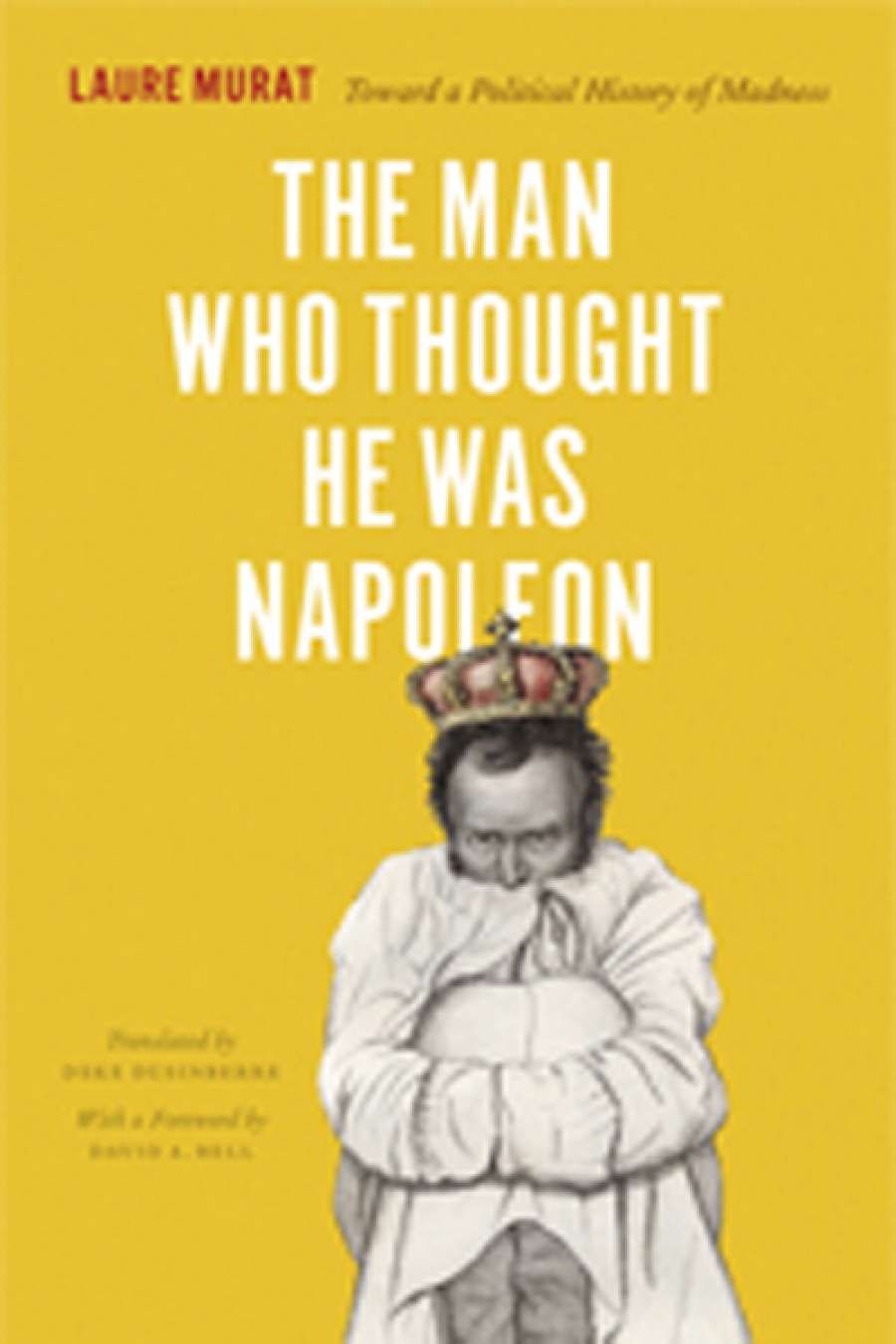
- Free Article: No
- Contents Category: History
- Custom Article Title: James Dunk reviews 'The Man Who Thought He was Napoleon: Toward a political history of madness' by Laure Murat
- Review Article: Yes
- Online Only: No
- Custom Highlight Text:
In 1798, during the revolutionary wars on the European mainland, the Irish rebelled. Though they were supported militarily by the French Republic, it was the ideas heralded by the Revolution that gave real strength to their cause. A decade later, in Dublin, William Hallaran argued in his An Enquiry Into the Causes Producing the Extraordinary Addition to the Number of Insane that much of the increase should be attributed to the rebellion. Fifteen per cent of cases where causes could be identified were linked directly with the rebellion, but its effects were writ large in the rest of the catalogue: loss of property, drunkenness, religious zeal, disappointment, and grief.
- Book 1 Title: The Man Who Thought He Was Napoleon
- Book 1 Subtitle: Toward a political history of madness
- Book 1 Biblio: University of Chicago Press (Footprint), $79 hb, 304 pp
Seventeen ninety-eight is remembered in Ireland as Bliain na bhFrancach, the year of the French. The rebellion was a failed franchise of French philosophy, but it was also particularly French to read the histories of revolt and insanity together. French psychiatry became self-aware and ambitious during the Revolution, and rose to ascendancy in the decades of revolt and counter-revolt that followed. Its theories were sculpted from the hope, fear, and desperation of these upheavals. Madness and history converged in France, and this is the subject of Laure Murat’s monograph The Man Who Thought He Was Napoleon.
What, asks Murat, has madness to do with history? Does it only describe a part of its collateral damage? What does it mean that revolution itself was called mad, that the ‘line between ideology and pathology’ was malleable, that psychiatrists conjured homicidal monomania to wrest power from priests and courts, or that a century of political strife bequeathed medicine with a disease, morbid democraticus?
The book is subtitled Toward a Political History of Madness and, from preamble through to the short and searching postamble, it is more an excursion than a thesis. The book’s five chapters trace the history of madness through the string of revolutions: the insanity of the Terror and its use of the asylum; the chronicling of revolution in shifting delusions of grandeur; the conflation of ideology and madness after the springtime of the peoples, with various critiques of Second Empire economics written in its delusions; and the discourse of madness surrounding the Paris Commune of 1871. In its wake, writes Murat, the German physician Carl Stark decided that France itself suffered from delusions of grandeur, muttering about civilisation as it reeled from régime to régime.
As with Murat’s previous work, this is an eloquent piece of writing; asylum records, she quips, are more conducive to literature than to math. Idiosyncrasy in diagnosis, treatment, and recording make it difficult to analyse madness numerically; the blank pages of asylums evacuated, say, as the Prussians approached, make it harder still for this period. Imperfect records suit Murat’s approach, however, which is dominated by immersion in psychiatrists’ colourful historiettes. On this she cites Rabelais: the historian, like the fool, ‘clears his fancies of those plodding studies which harbour in the minds of thriving men’, and embraces a certain abandon.
Here, abandon produces intimate stories of science, medicine, and madness. Murat’s account of Phillipe Pinel, the legendary physician supposed to have cast off his patients’ chains to forge a new era in the treatment of the insane, not only corrects the mythology but dwells on his shyness, revolutionary enthusiasm, and various contradictions. By narrating the inflections of the man, Murat reveals the inflections of his theories, and therefore the pitch and tone of the conversation he carried on with madness. She does the same for the guillotine, from its invention to its chill fall, which drove men and women mad; for the diminutive, ugly man who ‘treated’ the patently sane Marquis de Sade; and for the Communards who were diagnosed with manifold diseases by vindictive conservative psychiatrists. If past madness can be read and heard, it is in these ways and not in aggregation, because madness never organised itself into a single voice.
Murat’s account is rich. There is the deft discussion of the effect of violence on admissions: whether, that is, insanity is a function of history; the discomfiting links between psychiatry and politics, and between asylums and prisons; and the titular question: who was it that thought he was Napoleon? There were, as any nineteenth-century register shows, many who used Bonapartean vocabulary to express their frustrations and disappointments when their own language failed. Napoleon, suggests Murat, had particular purchase for these delusions of grandeur because he had made himself grand from nothing, and because he himself verged on madness.
Murat takes madness as an agent of history, as well as its subject. It is here an unpredictable interlocutor with political discourse. Sydney Smith himself wrote that the essence of every species of surprise is wit, and wit commands attention. The assumption underlying Murat’s work is that madness always speaks, always plays a part in politics. Murat inherits Foucault’s confidence in the explanatory power of madness: Tell me what you do with your mad and I will tell you who you are. Where Foucault abstracted from silence, Murat listens to madness, and writes its history.
The Man Who Thought He Was Napoleon is a precise and agile step Toward a Political History of Madness. As with all fine scholarship, this work opens realms of enquiry rather than sealing them off. These ties between madness and history established, what might emerge from other pasts, where different spirits stalked?


Comments powered by CComment